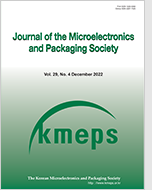
Search
- Past Issues
- e-Submission
-

KCI Accredited Journals KCI 등재지
KCI Impact Factor 0.54
Editorial Office
- +82-2-538-0962
- +82-2-538-0963
- kmeps@kmeps.or.kr
- http://kmeps.or.kr/

KCI Accredited Journals KCI 등재지
KCI Impact Factor 0.54
Journal of the Microelectronics and Packaging Society 2024;31(3):87-90. Published online: Oct, 30, 2024
DOI : doi.org/10.6117/kmeps.2024.31.3.087
Currently, when oxides are used as insulators in hybrid bonding for 3D integration, they are prone to delamination due to their surface characteristics, and the RC delay value due to the resistance of the metal and the capacitance of the insulator increases as the wiring of the semiconductor chip becomes longer. To solve these problems, we studied the optimization of the conditions of the polymer insulator bonding method for hybrid bonding. To check the possibility of the de-wetting method, we coated a polymer film on the existing micro pillar and conducted hot-press bonding to remove the polymer between the metals. Through this study, it is expected that the introduction of polymers as insulators in hybrid bonding and fine-pitch metal bonding will improve signal transmission speed by reducing RC delay. It is also expected to be commercialized in the future to increase the number of I/O terminals by applying it to hybrid bonding.
Keywords 3D integration, Hybrid bonding, Polymer dielectric, Passivation layer